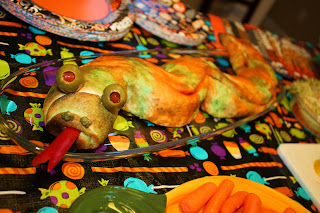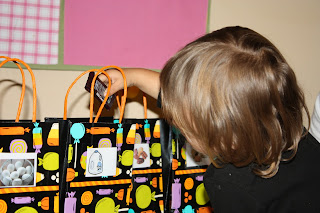In my experience, most parents of allergic kids have a moment when the seriousness of food allergies really sets in. For us, it was Elena’s first severe reaction. The reaction that woke us up took place 8 months after her diagnosis.
At the time of Elena’s diagnosis and in the months immediately following, all we had ever seen in reaction to food exposure were hives, redness, and maybe a little bit of puffiness in Elena’s face. This would happen after being around someone who had eaten one of her allergens or being in a public place where she came in contact with a surface that had touched an allergen. With dairy being one of her allergens, that means any public place where children bring snacks. She reacts to goldfish dust, anything cheesy, sippy cup milk spatter, and basically everything else typical toddlers consume. We knew her allergies could be life threatening and we considered ourselves diligent.
On the evening of “the big one”, we were staying in a Bed and Breakfast in Pinehurst. It was Mother’s Day weekend and we met some friends there for a weekend getaway. We met the other family in the restaurant attached to the B&B for dinner. While placing our order, we went through the usual rigamorole with the waitor, who must have been every bit of 17 years old. We asked if the black bean burger was vegan and were told that it was. The waitor thought there could be egg in the bun, so we left it off. We ordered her a side of fruit, which is always a safe option, right? Just to be safe, Justin and I ordered the same thing, only we kept the buns. Whew, ordering is always the hardest part. How nice that he thought to warn us about the bun, though.
We enjoyed our dinner, but the black bean burger seemed a bit too spicy for Elena. She only ate a bite or two. She started to get a little fussy about half way through the meal and kept rubbing her eyes. It had been a long day and we knew she must be tired from the drive, which explained the eye rubbing. She was also teething, so we thought the fussiness could be partially due to pain. I took her up to our room and gave her a dose of Tylenol to help with the teething, then brought her back down. Since it was too early to put her to bed without throwing her schedule into a frenzy, we decided to walk around Pinehurst and get some fresh air.

We started walking, waiting for the Tylenol to kick in. Elena continued to rub her eyes and one began swelling. We wondered if it could be a food reaction. The thought had not occurred to us because we felt certain she hadn’t eaten anything unsafe. Normally we would give her Benedryl even if we suspected it a possibility, but I had just given her a dose of Tylenol and wasn’t sure about mixing them. We decided to walk back to the room and hoped she would improve.

She did not.
Elena was becoming lethargic and her face was continuing to swell around her eye and her voice was becoming hoarse. When we got to the room, she began vomiting. We were still unsure what was going on, but we gave her Benedryl just in case. She continued vomiting, which meant the Benedryl did not have time to work. We took off her clothes to put her in the bathtub and try to clean her up and found red, angry looking hives covering her torso. At this point, we still weren’t sure it was a food reaction, but we were sure it was bad. She was lethargic and we were panicking. We grabbed the Epipen, put her in the car seat and headed toward the hospital. Luckily the ER was less than 5 minutes away from where we were staying. We held the Epipen close, but were afraid to use it because she seemed to be breathing fine.
When we got to the ER, we bypassed the line and they got us into a room right away. We told them we thought she was having an allergic reaction, but we didn’t know what she could have eaten. They gave her steroid shots and something to control the vomiting. When the vomiting subsided, they gave her Benedryl orally. We stayed for a good part of the night while they observed her, then we were released with an oral steroid and Benedryl regimen to continue for the next couple of days.

We later found out that the Black Bean burger patty had egg and milk ingredients.
We learned so much from this experience. We learned the importance of speaking with a manager at a restaurant about food ingredients. We also learned that a reaction does not fit into a neat little check list of symptoms. I’m not sure exactly what we expected a reaction to look like, but the whole time we kept questioning whether or not that was what was happening. We should have given her Benedryl as soon as her face started swelling. We should not have been so reluctant to use the Epipen. We learned the importance of having a clear and precise action plan that leaves no room for last minute decision making. Every person can present differently during an allergic reaction and even the same person can present differently during subsequent reactions. No two reactions can be expected to look the same. We were so lucky that our outcome was not worse.
Since this event, Elena has had a couple of less severe reactions and we have acted quickly. We will never again take a chance. If we suspect any level of reactivity, she gets Benedryl. We have even given her Benedryl and driven to the ER parking lot to wait for it to kick in. We have learned that her reactions do typically begin with swelling and redness around one eye, but we will never discount other symptoms. All reactions since “the big one” have been due to sources we were never able to decipher. They were likely cross contamination exposures due to someone cooking with a shared utensil. They have all occurred while dining outside of our home.
We consider ourselves blessed to have been given an opportunity to learn such valuable lessons. So many never get a second chance. Every time I hear about a food allergy related death occuring with the first severe reaction of the victim, I am reminded how lucky we are. Let our wake up call be yours as well. Have a solid action plan and make sure you understand it and know exactly how to proceed no matter what symptoms you are faced with. Most importantly, take precautions and pray that your plan never has to be implemented.
 2 cans of refrigerated crescent dough (We use Pillsbury Original or Reduced Fat)
2 cans of refrigerated crescent dough (We use Pillsbury Original or Reduced Fat) 4) Sprinkle clean dry surface with flour. Unroll one tube of crescent dough and lay flat on floured surface. Press seems together with fingers to seal. Sprinkle a light dusting of flour over the dough sheet and roll (length-wise) with a rolling pin until sheet is smooth and seems appear closed.
4) Sprinkle clean dry surface with flour. Unroll one tube of crescent dough and lay flat on floured surface. Press seems together with fingers to seal. Sprinkle a light dusting of flour over the dough sheet and roll (length-wise) with a rolling pin until sheet is smooth and seems appear closed. 
























